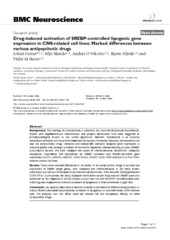| dc.description.abstract | Background: The etiology of schizophrenia is unknown, but neurodevelopmental disturbances, myelin- and oligodendrocyte abnormalities and synaptic dysfunction have been suggested as pathophysiological factors in this severe psychiatric disorder. Cholesterol is an essential component of myelin and has proved important for synapse formation. Recently, we demonstrated that the antipsychotic drugs clozapine and haloperidol stimulate lipogenic gene expression in cultured glioma cells through activation of the sterol regulatory element-binding protein (SREBP) transcription factors. We here compare the action of chlorpromazine, haloperidol, clozapine, olanzapine, risperidone and ziprasidone on SREBP activation and SREBP-controlled gene expression (ACAT2, HMGCR, HMGCS1, FDPS, SC5DL, DHCR7, LDLR, FASN and SCD1) in four CNSrelevant human cell lines. Results: There were marked differences in the ability of the antipsychotic drugs to activate the expression of SREBP target genes, with clozapine and chlorpromazine as the most potent stimulators in a context of therapeutically relevant concentrations. Glial-like cells (GaMg glioma and CCF-STTG1 astrocytoma cell lines) displayed more pronounced drug-induced SREBP activation compared to the response in HCN2 human cortical neurons and SH-SY5Y neuroblastoma cells, indicating that antipsychotic-induced activation of lipogenesis is most prominent in glial cells. Conclusion: Our present data show a marked variation in the ability of different antipsychotics to induce SREBP-controlled transcriptional activation of lipogenesis in cultured human CNS-relevant cells. We propose that this effect could be relevant for the therapeutic efficacy of some antipsychotic drugs. | en_US |

